I realize that I’ve posted about writing spiders before, so for more information about their feeding habits, and web construction, you can see the previous post here.
However, this morning I encountered not one, but TWO species of Argiope spiders, suspended in their respective webs, less than a foot apart from each other.


I was a little surprised to see them though, as I don’t usually expect to see many of these spiders until mid-late October.
I first noticed this very large female Banded Garden Spider (Argiope trifasciata) a few days ago, tucked into a prostrate rosemary shrub at the top of the orchard bank.
As we often see here in the fall, she was dining on a cocooned honey bee that she’d likely caught earlier in the day.
While I was taking a couple of photographs this morning though, I noted what I thought were galls out of the corner of my eye. We find various shaped galls on our oaks, and wild roses, all the time, but I’ve never seen any sort of gall on a rosemary plant. As I pulled the camera away from my eye though, I realized this wasn’t a gall at all, it was an Argiope egg sac!
In my last post about these spiders I mentioned that I’d keep my eye out for egg sacs, but never did actually find any, even though we see these spiders in our gardens every fall.
That said, often when I find these spiders they’ve been in somewhat exposed locations, either out among the decaying foliage in the winter squash garden, or suspended between tree branches in the orchard, with no secluded location to shelter an egg sac.
This time though, there wasn’t just one, but TWO of them neatly tucked down between the rosemary branches, and quite well camouflaged. They’re not small either, each measuring at least a 1.5 cm in diameter.
Females are known to produce between one and four egg sacs, each of which may contain close to a thousand eggs. Each protective sac is constructed of a tough brown paper-like silk.
Although I had a good dorsal view of this spider, I climbed back up the bank to look at little more closely at her meal that she was keeping securely underneath her.
My footing was a bit tricky, and I could smell the pungent aroma of crushed rosemary leaves as I maneuvered myself into a better position, and then I noticed a second web, with another spider, just inches from the first.
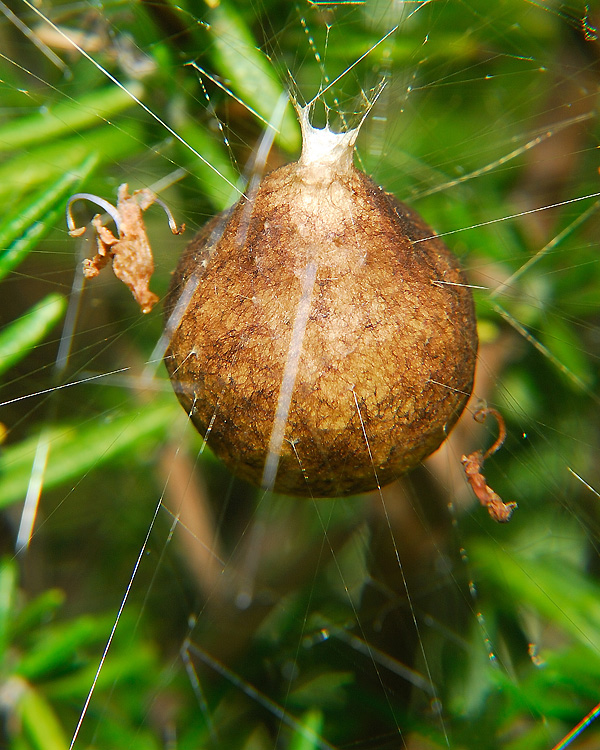

This one though is a different species, the yellow and black garden spider (Argiope aurantia) that I wrote about previously.
This image gives you an idea of how close together these spiders were. There’s no question that prostrate rosemary makes for great spider habitat. It’s a good thing I’m not an arachnophobe, in fact, I welcome seeing so many spiders in the garden.
While I was trying to get a photograph of this yellow and black garden spider, she bounced, very abruptly, toward my lens, startling me enough that I almost slipped down the slope.
As I looked over the top of the view finder I saw why she had moved so suddenly.
Brunch had arrived, in the shape of a grasshopper.
She paused for a few seconds, with threads from her spinnerets poised. Then she quickly began to spin, flip, wrap, and gradually entomb her prey, to dine on this morsel later.

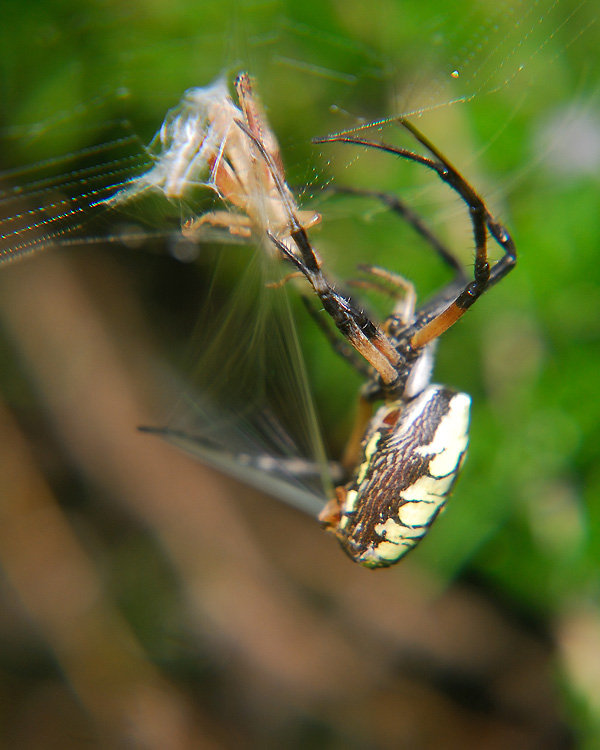
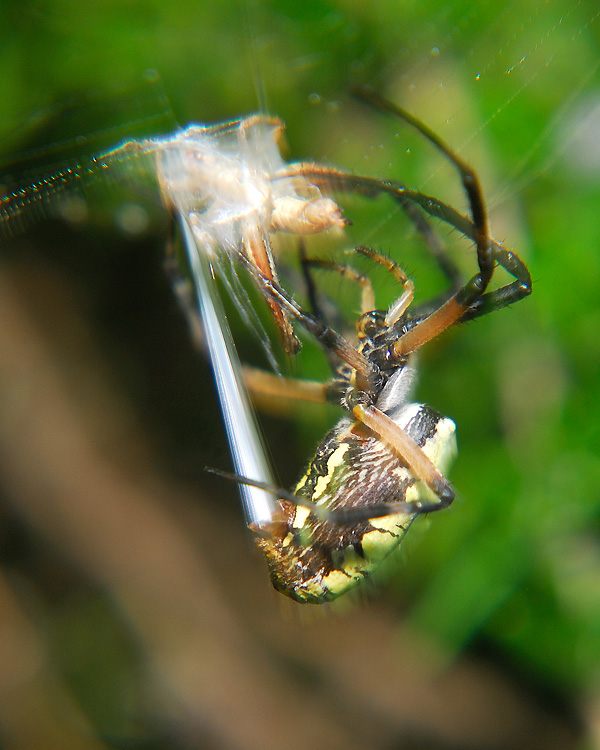
I’m always impressed with the amount of silk spiders can produce. Writing spiders are renowned for reconstructing their intricate webs each day, but seeing how much silk they can produce all once, for a task such as this, really is quite impressive.
And then, just before she finished wrapping her meal, my camera battery died. Of course! When she was done though, her meal looked remarkably like this one I found in the orchard last year.
Both of these spiders seem quite content to be lurking in the rosemary, which is producing just enough blooms at the moment to entice the occasional meal toward one of their webs. I’ll be watching the eggs sacs very closely this winter though, and as they’re quite low to the ground we’ll be careful during fall cleanup so we don’t damage them.

The young will hatch inside the sacs over winter, and if they can avoid being predated on, they should emerge once the warm weather returns next year. I’m really looking forward to having an opportunity to see some Argiope spiderlings emerge next spring!

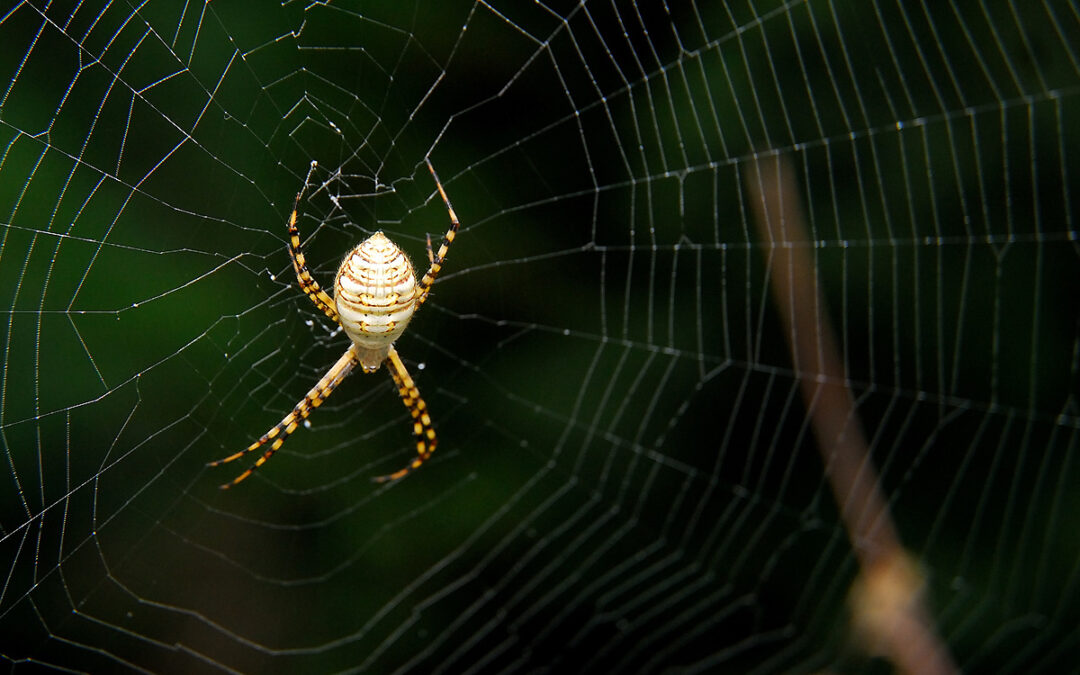
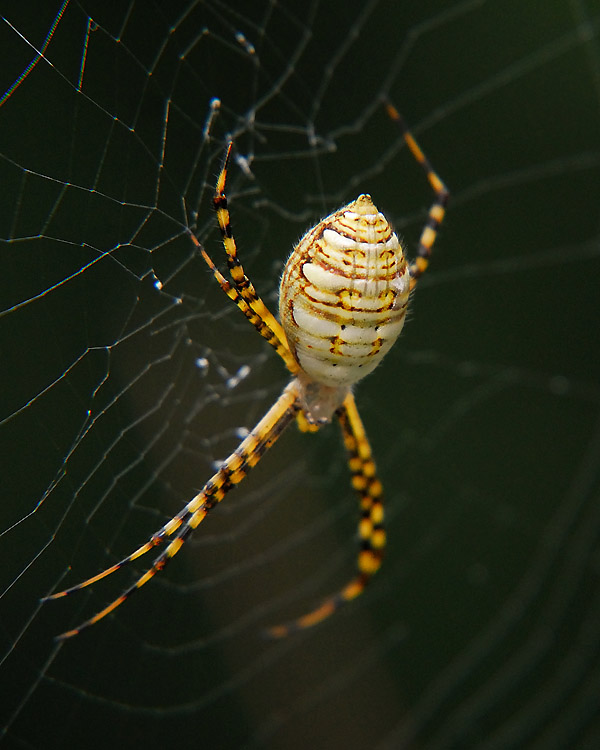
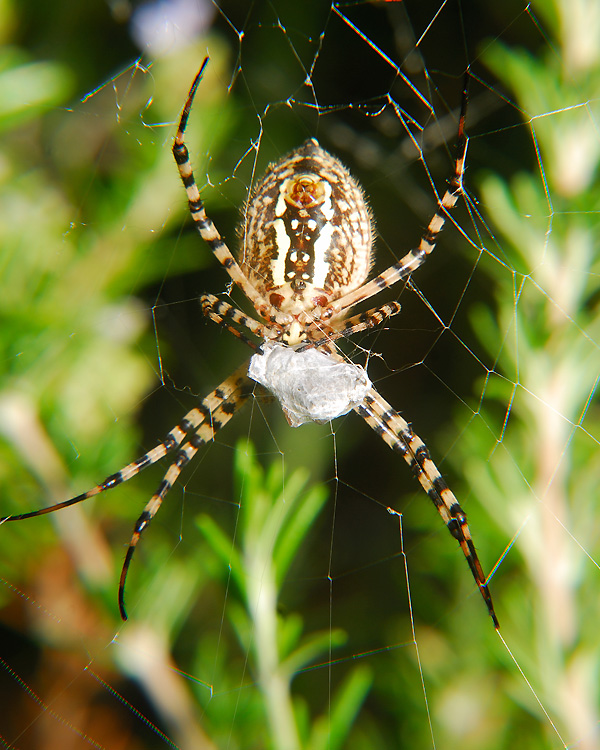
That is the most amazing spider shots!! And they are so active! WOW! Thanks for sharing – I’ll be more careful when picking rosemary!
It’s the first time I’ve seen the rosemary so…occupied! It’s smart though. Unlike some of the other places I’ve seen these spiders in the autumn months, the rosemary at least is evergreen here, so these egg cases should stay well hidden through winter.
I never tire of watching the writing spiders catch prey (sorry bees). It’s just so interesting to watch them catch, hold, and then wrap up their lunch into neat little packages!
Awesome action shots, Clare! And so cool that you found the egg cases. I’ve been delighted at finding 5 argiope – all one species, different from yours, but not sure which one – in my garden this year. Feels like an affirmation that we’re doing something right.
I agree, if nothing else these ladies are finding plenty to eat, and as we don’t spray we’re happy to have some extra predators helping in the garden. The banded female was HUGE, almost twice as large as the other, so she’s certainly well fed! Finding the egg cases was a definite bonus 🙂
Clare, I always learn something from you. I’ve been wondering what spider I’ve been wearing all week. This time of year, I can’t walk ten feet in any direction without being snag by the web of one of these lurking beauties. I’ve yet to see any egg sacs but now I know what to look for. Take care, Tom
Every once in a while, usually early in the morning before my coffee has kicked in, I’ll stumble through a huge web. One year a female kept stringing up her web just above the orchard gate, and I had one that would be strung across the path to the garden. Some of these webs can be enormous, and if the spiders haven’t written the pattern through the center of the web, they’re not always easy to see before they get tangled in your hair. Certainly if you see a spider down in some vegetation though, not out in the open, look nearby for these egg sacs. They’re not easy to see. It’s taken me a few years to find my first ones here! 😛
Interesting little guys! I’ll have to watch for these in my rosemary…
For years, I was conditioned to hold out my hand in front of my face when stepping out my front door. A large spider, we named Harry, spun a web each morning, from a juniper to the rose bush right across the porch.
Too many times, I got a face full of web. Thanks for this neat post!
I’m always wondering where the spider is after I walk through a web! I’ll have to remember the holding my hand out in front of me trick when I’m going out to the garden this fall! 😉
We have had spiders on the mind, too. In San Diego, our native Black Widow populations have been out competed by Brown Widows, a close cousin. We noticed just this past year that we were seeing fewer and fewer — and now not one — Black Widows.
Oh, we have black widows too. The largest one I’ve ever seen was protecting her own egg cases in a coyote brush shrub recently. Her size was absolutely impressive. When I find them the house, which is rare, I think they’ve usually hitched a ride in on a piece of firewood.
I read about the non-native brown widows out competing the native black widows in southern California. Although the brown widows are less poisonous, as a biologist, I do think it’s unfortunate that they’re displacing our native species 🙁
Love the yellow and black! Great shots!
When my camera tells me the battery is done, I usually just turn it off, wait 2 seconds, and turn it on again. For some reason that usually gets me several more shots.
I wish my camera would let me do that. Once my dead battery icon flashes, it’s done. I think my old clunky camera just needs too much juice to shoot even a single photo 😛
Great informative post, and the shots of the spider wrapping the grasshopper are especially interesting. When I was a boy we used to toss grasshoppers and flies into webs to watch the spiders cocoon them, but it’s been a long long time since I’ve seen that. For the past few weeks we’ve been watching a large black and yellow garden spider whose web is by our pig shed. She has a large egg sac nearby. Thanks to your posts I now know a lot more about these creatures.
Sounds like the spider by your pig shed should called Charlotte 😉 These spiders are spiders, as of this morning, are still in the rosemary, and the egg sacs are there. I swear they both look bigger though, it must all the grass hoppers are bees they’re snacking on!
Like you I’m finding spiders everywhere these days. Where are they earlier in the summer I wonder? We get lots of the yellow and black ones as well. Unfortunately I find myself damaging lots of egg sacs as they seem to like my vegetable garden and inevitably the sacs get knocked about as I pick veggies and do fall clean up. Some must survive though because back they come every year.
You know, I’ve wondered where they hide the rest of the year. I think the writing spider females often don’t breed until their second year, but I only really notice these spiders around in late September and October. I’m just not sure why I don’t see them the rest of the year.
Clare these photos are amazing captures of spiders in action…quite menacing looking but I love them as well. I have seen many signs of an early fall this year.
These spiders are fun to photograph, except when they lurch toward the lens 😉 As they’re larger, it’s much easier to see their features. I just wish they’d catch more yellow jackets than bees!